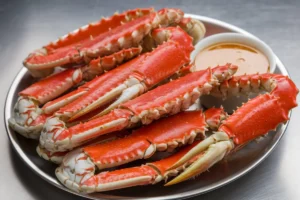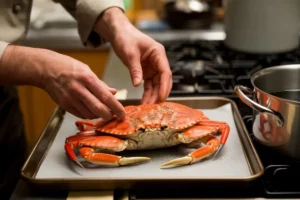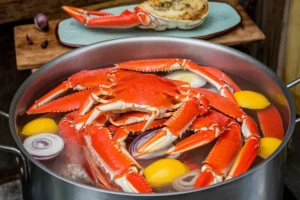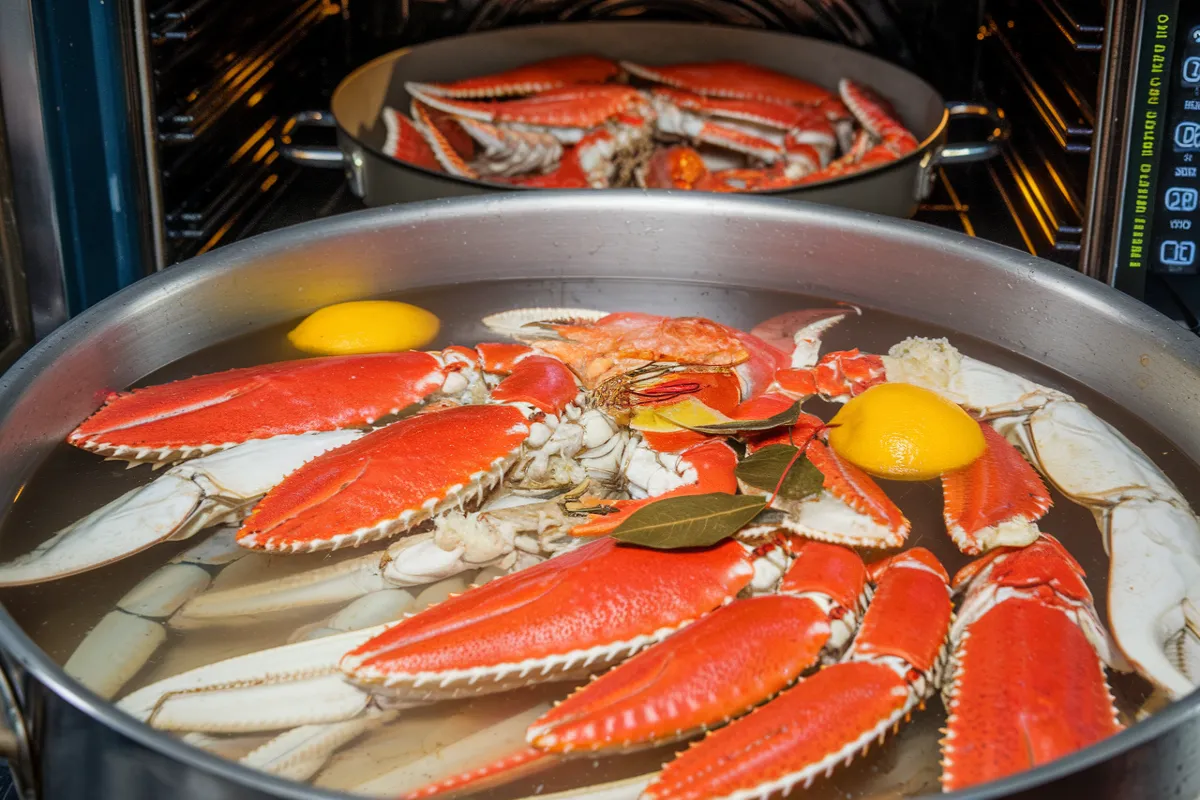Is It Better to Boil or Bake Snow Crab Legs?
Snow crab legs are a popular delicacy that can elevate any meal with their sweet, tender meat. The cooking method you choose—whether it’s boiling or baking—can significantly impact the flavor, texture, and overall enjoyment of this seafood. This detailed guide explores both cooking methods, breaking down the pros and cons of each, to help you decide the best way to prepare your snow crab legs.
Why Cooking Method Matters
Choosing the right cooking method is essential to get the most out of your snow crab legs. Boiling is often praised for its simplicity and speed, but some argue that it can dilute the flavor. On the other hand, baking allows you to infuse your crab legs with rich seasonings, but it takes a bit more time. Understanding these differences can help you make an informed choice based on your culinary preferences and the equipment you have at home.
According to the Pros and Cons of Each Cooking Method for Crab, each method offers unique benefits. Boiling tends to retain moisture, making the crab legs tender and succulent, while baking offers more control over the flavor, allowing you to experiment with various seasonings and sauces.
For those new to cooking seafood, boiling may seem like the easier option. A guide to boiling crab legs notes that boiling is straightforward and less likely to dry out the meat. However, baking enthusiasts argue that the extra time is worth the richer taste and enhanced textures that baking provides.
Boiling Snow Crab Legs
Boiling is one of the most traditional methods for cooking snow crab legs. It’s a quick process that doesn’t require much preparation, making it ideal for busy weeknights or when you need to cook large quantities at once.
Pros of Boiling:
- Retains Moisture: Boiling ensures the crab meat remains tender and juicy.
- Quick Cooking Time: Crab legs can be ready in just a few minutes.
- Ease of Preparation: Little to no prep is needed; just add water and seasonings.
Cons of Boiling:
- Diluted Flavor: Some of the natural sweetness and briny taste can be lost in the water.
- Risk of Overcooking: If left too long, crab meat can become rubbery.
Step-by-Step Guide to Boiling Snow Crab Legs:
- Preparation: Fill a large pot with water. Add a pinch of salt, a squeeze of lemon juice, and optional aromatics like bay leaves or garlic cloves for extra flavor.
- Boiling Process: Bring the water to a rolling boil, then carefully add the crab legs. Boil for 4-5 minutes, or until the meat is hot throughout.
- Finishing Touches: Remove the crab legs using tongs and let them drain. Serve with melted butter or a dipping sauce of your choice.
Tips for Enhancing Flavor When Boiling:
- Season the Water: Adding herbs, spices, and a bit of wine or beer can infuse the crab with subtle flavors.
- Don’t Overcrowd the Pot: Boiling too many legs at once can cause uneven cooking.
- Use a Steamer Basket: Elevate the legs slightly to avoid direct contact with the water for a gentler cooking process.
Boiling is perfect for those who love a classic, no-fuss approach to cooking crab legs. It’s a reliable method that produces consistently delicious results with minimal effort.
Baking Snow Crab Legs

Baking offers a different approach to cooking snow crab legs, one that allows for creativity and customization. By baking, you have the opportunity to add layers of flavor that permeate the meat, making each bite more flavorful.
Pros of Baking:
- Flavor Infusion: Baking allows you to season the crab legs directly with herbs, spices, butter, and sauces.
- Crispier Texture: The heat from the oven can add a slight crispness to the shell, enhancing the dining experience.
- Versatility: You can bake crab legs with a variety of ingredients, from simple garlic butter to complex marinades.
Cons of Baking:
- Longer Cooking Time: Baking takes longer than boiling, typically about 10-15 minutes.
- Risk of Drying Out: Without proper monitoring, the meat can become dry and tough.
Step-by-Step Guide to Baking Snow Crab Legs:
- Preparation: Preheat your oven to 375°F. Arrange the crab legs on a baking sheet lined with aluminum foil.
- Seasoning: Brush the legs with melted butter, garlic, and your favorite herbs. For a spicier kick, sprinkle on some Old Bay seasoning or paprika.
- Baking: Cover the legs loosely with foil to prevent them from drying out, and bake for 10-15 minutes until heated through.
- Serving: Remove from the oven, and serve with additional melted butter, lemon wedges, or your favorite dipping sauce.
Flavor Enhancements:
- Garlic Butter: A classic choice that adds richness and depth to the crab meat.
- Lemon and Dill: For a lighter, fresher flavor, drizzle with lemon juice and sprinkle with dill before baking.
- Spicy Cajun: Mix butter with Cajun spices for a Southern twist.
For more detailed instructions, check out How to Cook Perfect Crab Legs which provides expert tips on achieving the perfect bake.
Additional Cooking Methods
While boiling and baking are the most popular ways to prepare snow crab legs, other cooking methods offer unique benefits that might suit your taste.
Steaming
- Benefits: Steaming retains the most flavor and moisture compared to boiling or baking.
- Process: Place crab legs in a steamer basket over boiling water and steam for 5-7 minutes.
- Flavor: Steaming keeps the meat sweet and tender without diluting the flavor.
Microwaving
- Benefits: Fast and convenient for reheating crab legs.
- Process: Wrap crab legs in a damp paper towel and microwave on high for 2-3 minutes.
- Caution: Microwaving can cause uneven heating and toughen the meat if overcooked.
Grilling
- Benefits: Adds a smoky, charred flavor that complements the natural sweetness of the crab.
- Process: Brush crab legs with oil or butter, then grill over medium heat for about 5 minutes per side.
- Flavor Profile: Grilling enhances the texture and provides a delicious contrast between the soft meat and slightly crispy shell.
Health and Nutritional Considerations

Snow crab legs are not only delicious but also packed with nutrients like protein, omega-3 fatty acids, and essential vitamins and minerals. However, the cooking method can affect their nutritional value:
- Boiling: Maintains the nutritional profile with minimal added fats. The lightest option calorie-wise, especially if you skip the butter.
- Baking: Adds calories if you use butter, sauces, or oils, but can also provide healthy fats if olive oil or other alternatives are used.
Both methods are low in carbohydrates, making them ideal for low-carb or keto diets. Just be mindful of the extras you add during the cooking process.
Time, Effort, and Skill Level
When deciding between boiling and baking, consider your own cooking skills and the time you have available:
- Boiling: Quick and requires little attention, making it perfect for beginners or those short on time.
- Baking: Requires more preparation and a bit more skill in monitoring the oven to prevent overcooking.
Which Method is Best for You?
- If you’re a beginner or need a quick meal, boiling is the way to go.
- If you enjoy experimenting with flavors and don’t mind spending a little extra time, baking offers endless possibilities.
Flavor Profiles and Seasoning Ideas
No matter which method you choose, seasoning is key to enhancing the natural flavors of snow crab legs. Here are some ideas to inspire your next seafood feast:
- Classic Garlic Butter: Melted butter with garlic, lemon juice, and parsley.
- Asian-Inspired: Soy sauce, ginger, garlic, and a drizzle of sesame oil.
- Mediterranean: Olive oil, oregano, lemon zest, and crushed red pepper flakes.
Experiment with different combinations to find the perfect flavor profile that suits your palate.
Frequently Asked Questions (FAQs)
Q: Which method retains more flavor, boiling or baking?
- A: Baking retains more flavor due to the ability to add seasonings directly onto the crab legs, whereas boiling can dilute some of the natural taste.
Q: Can I overcook snow crab legs? How can I avoid it?
- A: Yes, overcooking can make the meat rubbery and tough. Boil for no more than 5 minutes and bake for no more than 15 minutes, keeping a close eye on the process.
Q: How long should I cook snow crab legs?
- A: Boiling takes about 4-5 minutes, while baking usually requires 10-15 minutes. Steaming typically takes 5-7 minutes.
Q: Is it necessary to thaw crab legs before boiling or baking?
A: Yes, it is necessary to thaw crab legs before boiling or baking to ensure even cooking. Thawing helps the heat penetrate the meat evenly, preventing the outer parts from overcooking while the inside remains cold or undercooked. You can thaw crab legs by placing them in the refrigerator overnight or, for a quicker method, run them under cold water for a few minutes. Avoid using hot water or microwaving, as these methods can begin to cook the crab legs unevenly before you actually start boiling or baking them.
Q: Can I bake crab legs without foil?
- A: Yes, but covering them loosely with foil helps retain moisture and prevents the meat from drying out.

Conclusion: Which Method is Best?
Ultimately, the best cooking method for snow crab legs comes down to personal preference. Boiling is ideal if you’re after a quick, tender result, while baking offers the opportunity to infuse the crab legs with additional flavors. Both methods can produce delicious snow crab legs with the right approach.
Experiment with both techniques to find your favorite, and don’t hesitate to mix things up with different seasonings and sauces. Whether you boil or bake, snow crab legs are sure to be a hit at your next meal.

